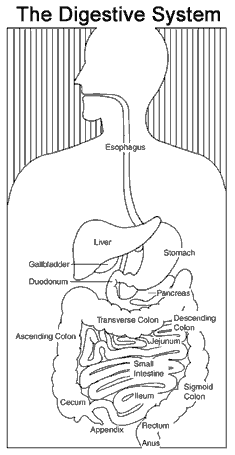Anatomy & Physiology of the large intestine
 It is important for enemas and colon cleansing to understand the
anatomy and physiology of the large intestine also called colon or bowel.
It is important for enemas and colon cleansing to understand the
anatomy and physiology of the large intestine also called colon or bowel.
The colon is part of our digestive system. It is one of the four (Skin, Lungs, Bladder, Colon) main elimination systems of the body. It is most important to get to know this part when you do enemas and colon cleansing.
Anatomy of the colon
Your colon is made up of sections with a total length of approximately 140cm and 170cm. Remember that this is only one part of your whole digestive system.
- * The cecum, where food enters from the small intestine
- * The ascending colon, on the right side of the body
- * The transverse colon extends from the splenic flexure to the hepatic flexure, across the
abdomen on the right. It follows a sagging course across, and in many people sags about ¾
of the way down to the naval - * The descending colon, on the left side of the colon further to the back
- * The sigmoid colon, a 'S' shape bend near the left groin.
- * The rectum, which is a powerful muscular organ about 14cm long, with a sphincter at each end.
- * The anus where faeces is eliminated from the body.
The colon has no villi (multiple, minute projections of the intestinal mucous layer which serve to absorb fluids and nutrients) as compared to the small intestine and produces no digestive enzymes. It is like a tube of circular muscle lined with a layer of moist mucous cells that lubricate the contents. The smooth folds of the colon are speckled with glands that resemble skin pores.
These glands extract the fluids and electrolytes from the passing food residue. Between 1/3 -1 liter of water (which is recycled and eventually filtered and excreted by the kidneys as urine), electrolytes, and some vitamins, are absorbed daily through the colon. If colon bacteria are normal, vitamins B-1, B-2, B-12 and K are produced by them, and all with the possible exception of B-12 are absorbed and used by the body traveling first to the liver via the portal circulation.
Absorption and storing fecal material are the colon's two main functions. The colon does secrete mucus to help the digested food along and hold the fecal material together. It also plays a role in protecting the walls of the colon from bacterial activity and neutralizes some of the fecal acids.
After processed matter from the small intestine enters the colon much absorption occurs in the cecum and ascending colon. Mixing movements called haustrations occur every few minutes and last about one minute apiece. They roll and mix the matter to expose most of it to the colon’s surface for absorption. Over 80% of the material reaching the colon is reabsorbed.
There are no peristaltic waves in the colon but a few times daily (usually after meals) a segment of the colon usually eight inches long will constrict (usually in the transverse or descending colon) to force the fecal material along. Our Feces are usually 75% water, 7-8% dead bacteria, 2-7% fat, .5-10% protein, 5-10% roughage, byproducts, digestive juices, etc.
Once the stool moves out of the sigmoid colon into the rectum, a parasympathetic reflex is set up and the brain gets the signal that nature is calling, and so we go.
The external sphincter is under voluntary control and we can mentally overcome this reflex and prevent defecation if we desire to. It is alwasy best to go immediatley when nature calls. Delays can result in constipation and other bowl problems
Of all the vital organs in the body, the one that suffers the most abuse from modern dietary habits is the colon.
Why is the colon so important? by Toni Schumacher Lund
One day the body got together and decided to have a board meeting. Here’s what went on behind closed doors. There was intense discussion to determine:
WHO WAS THE MOST IMPORTANT PART OF THE BODY.
The BRAIN was the first to speak. “Without me, nothing would be accomplished.”
Then the HEART spoke up. “Without me, pumping blood to your brain you could not function.”
The ARMS laughed. “You’re both wrong, without me to put food in the mouth, nothing would work.”
The LEGS quickly added. "Without me you couldn't get your food"
The STOMACH said, “Without me, your food would not digest.”
The LUNGS bellowed back, “Without me, you couldn’t breathe.”
The EYES blinked, “Without me you could not see.”
The KIDNEYS snorted, “Without me, you could not detoxify and eliminate.”
The COLON meekly spoke up. “I am important. You need me to eliminate all of the garbage from your systems.”
Everyone laughed and made fun of him. “How can you be as important as we are. You’re just a smelly old sewer.”
The poor colon...his feelings were hurt. He turned away, and thought, I’ll show them. HE SHUT DOWN!! Then he sat back and watched what would happen.
The BRAIN was stupefied.
The HEART’S beat was weak.
The ARMS and LEGS were weak and couldn’t move.
The LUNGS breathing was shallow.
The EYES became cloudy.
The KIDNEYS quit.
Then the COLON looked around and decided it was time to call another meeting.
It wasn’t too lively this time, but everyone was in total agreement.
The COLON WAS THE MOST IMPORTANT ORGAN.
